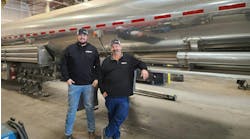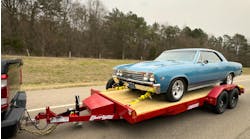Having made my third trip to the National Trailer Dealers Association annual convention, I feel like I’m getting a pretty good handle on the industry—and that really means knowing a lot more of who’s who, rather than what’s what.
I’m not saying that products don’t matter, or that I didn’t know anyone in the trailer business when I started at Trailer/Body BUILDERS. I’ve covered trucking for nearly 15 years and so I’m quite familiar with the brands, at least from a fleet perspective. And I’d had plenty of chats with trailer manufacturing executives before coming over to TBB.
But now, instead of asking what this or that recent trailer improvement means for a fleet customer’s operating margin and what’s the payback on the investment, I’m more interested in the processes behind that improvement: Where did the idea come from and what did it take to design and manufacture and market it?
Here’s the catch: The answers to my TBB questions often are not something to be shared with competitors—or at least that’s the first reaction. And that’s why my getting to know who’s who has been so important; or, rather, why it’s been so important for those people running the companies I cover to get to know me. And by that I mean to recognize me not just to say ‘Hi, Kevin’—although it’s nice to be on a friendly, first-name basis with folks—but as the editor of TBB.
Because while I’m feeling pretty good about getting a handle on transportation equipment manufacturing, distribution, upfitting, and sales, I’m really just the face of a publication that celebrates its 60th anniversary this month. And that legacy is why people are willing to share some inside insight; in short, they trust us.
And when I say ‘us,’ I hardly even figure into the equation. I’m routinely asked how Wanda and Paul are doing, referring to Wanda Tunnell, who with her father owned the well-established publishing company that launched TBB in 1959, and founding editor Paul Schenck. (And they’re both fine, thanks.) Bruce Sauer, who retired as editor in 2017, put in 40 years at TBB. I’d often introduced myself as ‘the new Bruce’—until someone who’s been in the business for a while suggested that he still thought of Bruce as ‘the new Paul.’
“People in the industry have known me for 60 years. They have to trust what you say is accurate, and that you have no selfish interests—that you are an independent voice,” Paul told me earlier this year when we were discussing the history of the magazine. “I’m very proud of the fact that we do this, that we do it and do it well.”
So while the faces at TBB have not changed much over our 60 years, the industry certainly has.
When we started publication in November 1959 manufacturers were completing a good year, building some 68,000 truck trailers and semi-trailers, according to Paul’s figures. The industry topped the 100,000-trailer milestone in 1965, and then hit the 200,000-trailer mark in 1974. The next plateau took another 25 years, with trailer production hitting 300,000 units in 1999 (our 40th anniversary). Appropriately, trailer output is projected to hit an all-time high this year at 326,000 trailers.
But the climb has hardly been smooth and steady. The economic cycles, changes in trucking and freight, and manufacturing challenges have reshaped the industry. When TBB launched, Fruehauf boasted a 35% market share and Trailmobile followed with 18%—together accounting for more than half of the trailers built in 1959. Also on Paul’s list Top 10 list: Highway Trailer, Brown Trailer, Gindy, and Lufkin. (Congrats to Great Dane and Utility Trailer for surviving and thriving.)
Of course, the equipment has changed substantially: Today’s LTL city trailers are longer than the standard full-size trailers 60 years ago, and I recently visited a trailer dealership whose new service bays are built to handle 57-footers, should the current 53-foot standard become obsolete any time soon. And steel has given way to aluminum and now to composites.
(For a Christmas gift, I highly recommend Marc Levinson’s The Box: How the Shipping Container Made the World Smaller and the World Economy Bigger, for an insightful look at the evolution of transportation equipment and how a better idea reshaped the supply chain.)
And don’t get me started about tomorrow. (We’ll have plenty on the future of trailers in next month’s coverage of the North American Commercial Vehicle Show.) We’re not all zipping about in the Jetsons’ personal spacecraft yet, but I’m betting electric and autonomous vehicles will be old news by TBB’s 70th anniversary.
The question for all of us: Are we prepared to deal with whatever changes the 2020s bring?










